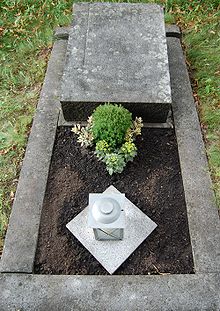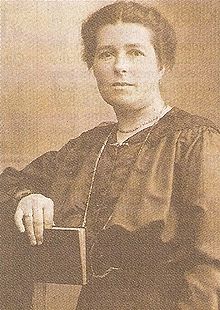Valentino Del Fabbro
Valentino Del Fabbro , also del Fabro (born September 17, 1866 in Tarcento , Friuli , Italy ; † May 7, 1915 in Bad Kissingen , Lower Franconia ) was an Italian craftsman (" terrazzo ") and entrepreneur in Bad Kissingen.
Life
Little is known about Fabbro's youth. He certainly attended the four-year elementary school (“Scuola elementare”) and learned basic knowledge of stone processing and terrazzo laying from relatives. Around 1885 Fabbro followed the call of his two uncles, who were already working in Germany, and left - like many of his compatriots before - his Italian homeland due to economic hardship.
Before he emigrated, he married Anna Batta-Ermacora (1876–1959). She was the daughter of a once wealthy, but later impoverished family, so that she had to work in a weaving mill when she was nine years old . The couple had six children (four boys and two girls), five of whom reached adulthood.
First Fabbro went to Wiesbaden , but when his first son Johann (Giovanni) was born in 1897, he lived and worked in Würzburg for the cement company "Treppo & De Marco". Around 1900 he came to the Lower Franconian spa town of Bad Kissingen and opened his own terrazzo shop there (today Erhardstraße 31). He was able to pay off the initially required partner in 1906. In 1913 he traded under the name "Valentino Del Fabbro Bad Kissingen - marble, mosaic and terrazzo floors, cement and asphalt work of all kinds". With his company he laid terrazzo floors in Lower Franconia a. a. in Bad Kissingen ( Regentenbau , Villa Hailmann and others), Großenbrach (today part of Bad Bocklet ), Bad Brückenau , Münnerstadt , Heustreu and Bad Königshofen .
Fabbro died on May 7, 1915, at the age of only 49, of pneumonia , perhaps a result of his occupation, and was buried in the Bad Kissingen chapel cemetery. His first tombstone was an upright terrazzo stone. Today's grave, on the other hand, is inconspicuous, the inscriptions on the gravestone are weathered and illegible.
Anna Del Fabbro
Valentino's wife, Anna Del Fabbro, tried to obtain German citizenship after the death of her husband , which was possible without any problems until the outbreak of the First World War (1914), but after Italy left the Triple Alliance with the German Reich and the The Austro-Hungarian Empire and Italy's declaration of war on Germany (1916) was made considerably more difficult or even impossible. In the case of Fabbro, the state feared that it would have to pay maintenance payments for five children, some of whom were still minors. Because with the death of the father, the company was initially closed and there was no income. Anna Del Fabbro died as an Italian in 1959.
Companies
Five years after his father's death, from 1920, his son Giuseppe and his brothers continued to run the father's business under the old company name. The brothers named terrazzo-laying, cementing, asphalting, cement workers and art board manufacturers as professions. The company later moved from Erhardstrasse to Bibrastrasse 1, where it remained until it was closed in 1981.
Brother Licurgo developed a process for producing a water-resistant, fire-proof and dust-free floor covering, for example as a base for linoleum , and received in 1939 a German Patent .
The last owner of the company, Viktor Del Fabbro , grandson of the company's founder Valentino, who had since been naturalized in 1956 , sold the company in 1981 to Bauer, which continued the name Del Fabbro until December 31, 1986.
literature
- Gerhard Wulz: Works of art under your feet. Terrazzo floors and the Italian immigrant Valentino Del Fabbro (1866-1915) , in: Saale-Zeitung of August 8, 2009, page 16
- Hermann Heidrich: Strangers in the Country , Franconian Open Air Museum (ed.), 2000, page 129
| personal data | |
|---|---|
| SURNAME | Fabbro, Valentino Del |
| ALTERNATIVE NAMES | Fabro, Valentino del |
| BRIEF DESCRIPTION | Italian craftsman and entrepreneur in Bad Kissingen |
| DATE OF BIRTH | 17th September 1866 |
| PLACE OF BIRTH | Tarcento , Friuli, Italy |
| DATE OF DEATH | May 7, 1915 |
| Place of death | Bad Kissingen , Lower Franconia |


